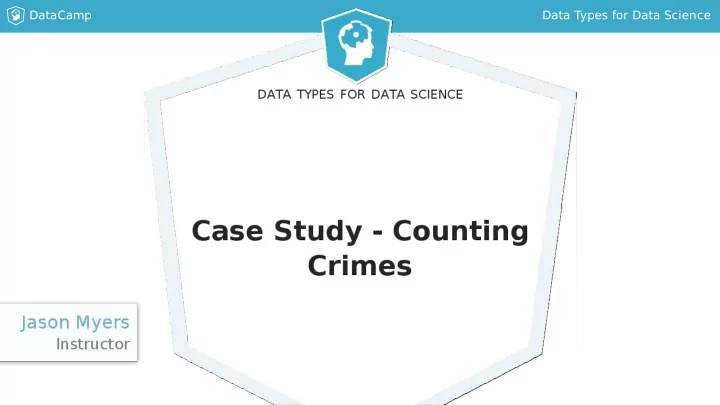

DataCamp Data Types for Data Science
DataCamp Data Types for Data Science Data Set Overview Date,Block,Primary Type,Description, Location Description,Arrest,Domestic, District 05/23/2016 05:35:00 PM,024XX W DIVISION ST,ASSAULT,SIMPLE, STREET,false,true,14 03/26/2016 08:20:00 PM,019XX W HOWARD ST,BURGLARY,FORCIBLE ENTRY, SMALL RETAIL STORE,false,false,24 Chicago Open Data Portal https://data.cityofchicago.org/
DataCamp Data Types for Data Science Part 1 - Step 1 Read data from CSV In [1]: import csv In [2]: csvfile = open('ART_GALLERY.csv', 'r') In [3]: for row in csv.reader(csvfile): ...: print(row)
DataCamp Data Types for Data Science Part 1 - Step 2 Create and use a Counter with a slight twist In [1]: from collections import Counter In [2]: nyc_eatery_count_by_types = Counter(nyc_eatery_types) Use date parts for Grouping like in Chapter 4 In [1]: daily_violations = defaultdict(int) In [2]: for violation in parking_violations: ...: violation_date = datetime.strptime(violation[4], '%m/%d/%Y') ...: daily_violations[violation_date.day] += 1
DataCamp Data Types for Data Science Part 1 - Step 3 Group data by Month The date components we learned about earlier. In [1]: from collections import defaultdict In [2]: eateries_by_park = defaultdict(list) In [3]: for park_id, name in nyc_eateries_parks: ...: eateries_by_park[park_id].append(name)
DataCamp Data Types for Data Science Part 1 - Final Find 5 most common locations for crime each month. In [1]: print(nyc_eatery_count_by_types.most_common(3)) [('Mobile Food Truck', 114), ('Food Cart', 74), ('Snack Bar', 24)]
DataCamp Data Types for Data Science DATA TYPES FOR DATA SCIENCE Let's practice!
DataCamp Data Types for Data Science DATA TYPES FOR DATA SCIENCE Case Study - Crimes by District and Differences by Block Jason Myers Instructor
DataCamp Data Types for Data Science Part 2 - Step 1 Read in the CSV data as a dictionary In [1]: import csv In [2]: csvfile = open('ART_GALLERY.csv', 'r') In [3]: for row in csv.DictReader(csvfile): ...: print(row) Pop out the key and store the remaining dict In [1]: galleries_10310 = art_galleries.pop('10310')
DataCamp Data Types for Data Science Part 2 - Step 2 Pythonically iterate over the Dictionary In [1]: for zip_code, galleries in art_galleries.items(): ...: print(zip_code) ...: print(galleries)
DataCamp Data Types for Data Science Wrapping Up Use sets for uniqueness In [1]: cookies_eaten_today = ['chocolate chip', 'peanut butter', ...: 'chocolate chip', 'oatmeal cream', 'chocolate chip'] In [2]: types_of_cookies_eaten = set(cookies_eaten_today) In [3]: print(types_of_cookies_eaten) set(['chocolate chip', 'oatmeal cream', 'peanut butter']) difference() set method as at the end of Chapter 1 In [1]: cookies_jason_ate.difference(cookies_hugo_ate) set(['oatmeal cream', 'peanut butter'])
DataCamp Data Types for Data Science DATA TYPES FOR DATA SCIENCE Let's practice!
DataCamp Data Types for Data Science DATA TYPES FOR DATA SCIENCE Final thoughts Jason Myers Instructor
Recommend
More recommend